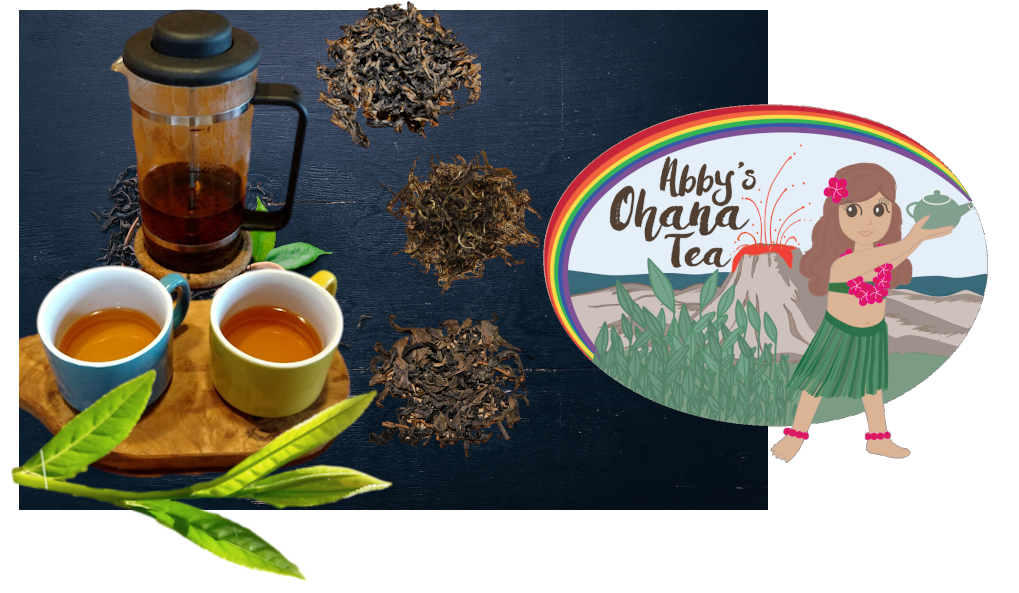
great taste and culture try abby's ohana tea
Artisanal loose leaf tea with a Hawaiian flare. Try Abby’s Ohana Tea to share in the story.
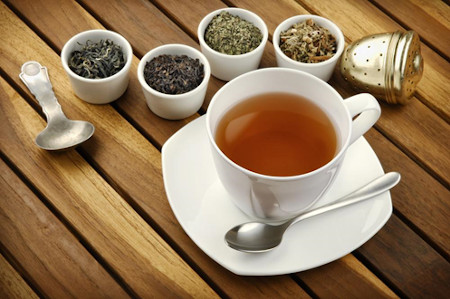
Originating in Asia thousands of years ago, tea is the most consumed beverage in the world after water. It started as a medicinal drink but it was then popularized as a recreational drink. In the 17th Century, tea became fashionable among the English.
The infusion is typically prepared by pouring hot water over cured leaves from the tea plant (Camellia sinensis), and it can also be prepared in teabags. In loose leaf tea, the tea leaves have enough room to absorb water and expand as they infuse. This way, the water flows through the leaves extracting their flavors, aromas, minerals, and vitamins.
The teabag is the cheapest and easiest way to prepare tea, but the infusion is limited by the size of the bag. Full leaves tea packed into a small tea bag makes it harder to appreciate all the flavor. However, in the last years, some tea merchants have adapted the tea bag to the tea by using more sophisticated tea flavor profiles and putting them into bigger bags allowing the leaves to expand more to create a better brew.
All these changes have raised the level of the tea bag but the loose leaf still offers the best quality of flavor and freshness. Using the full tea leaf provides more flavor and health benefits such as antioxidants.
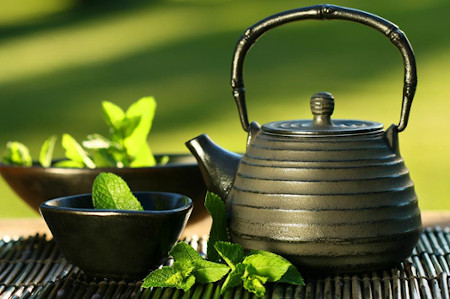
You don’t need to be a specialist to tell when you are in front of a good tea. To identify what loose leaf tea is better, you need to use four of your senses: sight, touch, smell, and taste.
High-quality loose leaf tea leaves look exactly like tea leaves. They shouldn’t look crumbly or seem to contain a lot of stalks and woody pieces. This makes it less flavorful and complex. When pouring the water, the leaves should unfold slowly.

When you touch them, dried tea leaves should feel slippery, smooth, whole, and sturdy. Also, they should have a slight heft. If they feel feather-light, they might indicate that they have been over-dried or too old. The best loose leaf would not disintegrate with gentle handling.
Good quality tea has a distinct aroma. When you inhale deeply and get only trace amounts of scent, it could be a sign of low quality or old tea. Green tea should smell light, fresh, and grassy, while black tea should smell earthy, sweet, and floral.
Finally, the taste is vital to identify high-quality loose leaf tea. The taste should be strong, recognizable, and mouthfeel. When you sip slowly, you should be able to detect different flavor notes.
To prepare a great cup of tea, place one teaspoon (around 2g) of loose leaf per cup of tea or two per cup if you are brewing white or yellow tea. Then, add hot water. Experts say that to get the best infusion possible, black tea needs freshly boiled water, as close as possible to 100 degrees Celsius. Black tea can be prepared with water straight off the boil.
It is recommended that you allow it to steep for 3-4 minutes. However, some loose leaves have specific requirements in terms of steep time. If they haven’t had the proper amount of time or there aren’t enough leaves, it will seem weak. On the contrary, if it steeps too long, it may take on a bitter taste. When you buy loose leaf tea, check what its recommended steep time is.
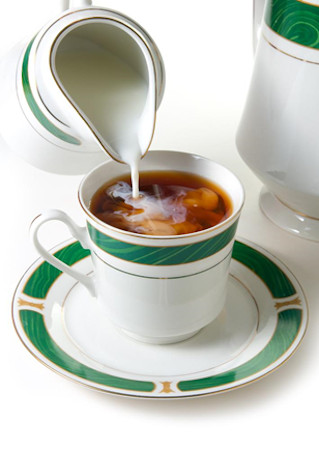
To finish your preparation, you can add some milk if you want. Many say that adding milk into infusing tea lowers the water temperature preventing a proper infusion from taking place. Perhaps the tea with milk does not allow to appreciate the tea to its maximum expression, but the truth is that it does not cause any harm to those who drink it.
Regarding the teapot, you can brew loose leaf tea in a western-style teapot -usually made from ceramics or porcelain- that don’t include a strainer. However, you will need a portable strainer when pouring tea into cups. Teapots with a strainer are the best option for large loose leaf tea since their holes are too small for large particles.

Artisanal loose leaf tea with a Hawaiian flare. Try Abby’s Ohana Tea to share in the story.

The true loose leaf tea is made from the Camellia sinensis plant, also called the tea plant. They are different from loose leaf herbal teas -also known as tisanes- as they are decaf and they do not include any Camellia sinensis leaves. Instead, they are made of spices, flowers, and leaves of other plants like fruits and herbs.
Loose leaf black tea is the world’s most common variety of tea and the best tea to drink every day. It is consumed by 75% of the world’s total tea consumption. The production process involves harvesting, rolling, and oxidizing and they contain the highest caffeine proportion among the true teas.
They have a stronger flavor and they contain antioxidants and theaflavins, good for heart health protection. Research has found that it can be an ally in lowering cholesterol levels which helps prevent cardiovascular disease.
Oolong tea is a medium between green tea and black tea, it is semi-oxidized and can help manage weight loss because it contains polyphenols and caffeine. White tea is the least processed variety of true tea since its leaves are plucked and sun-dried without any alterations and it tends to be the sweetest. It can be good to boost skin and hair health.
Some say that tea may be almost hydrating like water, but this depends on the variety of tea since they all have different amounts of caffeine which may affect your hydration in a different way.
Caffeinated teas (black, green, white, and oolong) typically provide 16–19 mg of caffeine per gram of tea, which means that you will have around 33–38 mg of caffeine in a teacup. Despite being lower in caffeine than coffee and other caffeinated beverages, drinking large quantities of tea could affect your hydration status and it might be bad for your kidneys too.
Tea leaves are edible both raw and steeped, and they are not considered a health hazard. However, they do not have any extra benefits or are especially recommended since the health benefits of the tea come from drinking the infusion. If you want to eat them, do it after steeping because they will be softer and easier to digest.
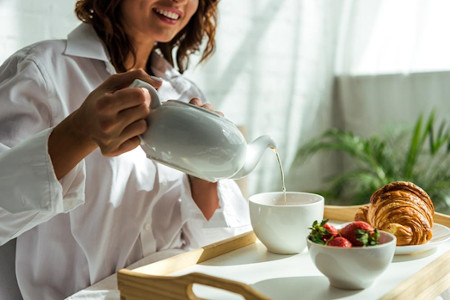

Loose leaf tea is very easy to find. Now, you can buy it in Starbucks, in wholesale stores, and online. However, if you want to dabble in loose leaf tea, you should look for a loose tea shop where the staff can provide some advice about what variety to try first.
If you don’t like tea, or if you are a beginner, it would be good to start with sweet varieties because the natural tea’s bitterness tends to put off new testers. You could start with honey bush teas, which are naturally sweet, or some tea blends like coconut macaron. It is also a good idea to start with fruit flavors like oranges, peaches, and berries.
Loose leaf tea is more expensive than tea bags because its quality is superior retaining its original flavor and is free from additives. The cost is even higher if you buy organic loose leaf tea. Buying bulk loose leaf tea may be cheaper -4 oz of loose tea can cost between $15 and $30-.
Herbal teas are considered the best allies to have a good sleep since they do not contain caffeine and they help relax and unwind. For centuries, people around the world have used it as a natural sleep remedy. Even though this benefit has not been scientifically proven, these are the most common teas used for that purpose:
Chamomile tea: It has apigenin, an antioxidant that is considered good to help initiate sleep.
Valerian root: It is believed that it increases the levels of a neurotransmitter called GABA which may improve overall sleep quality by shortening the time it takes to fall asleep and decreasing awakenings.
Lavender: It is famous for its relaxing aroma.
Lemon balm: It also increases the GABA levels and may decrease insomnia-related symptoms.
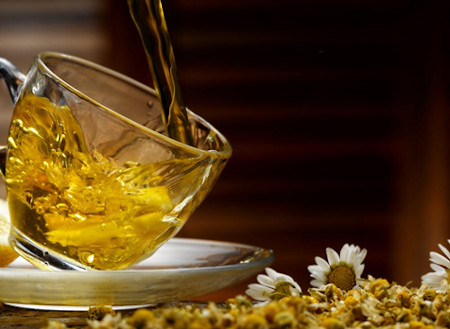
Tea can be brewed in a tea bag or loose leaf. While the tea bag is cheaper and easier to produce, the latter is sophisticated with a more intense flavor. True tea comes from the Camellia sinensis plant, and its leaves contain caffeine. It can be found in four main varieties: black, white, green, and Oolong. On the other hand, herbal tea or tisane is decaffeinated and many consider it a good ally for sleeping but this hasn’t been proved yet.
If you want to dabble in tea, it is best to find a place where they can give you information. It is recommended to start with the sweetest and most fruity varieties since loose leaf tea naturally has a bitter taste. The best way to prepare it is with hot water, using the right proportion of leaves, and steeping it for the time required for that particular variety.